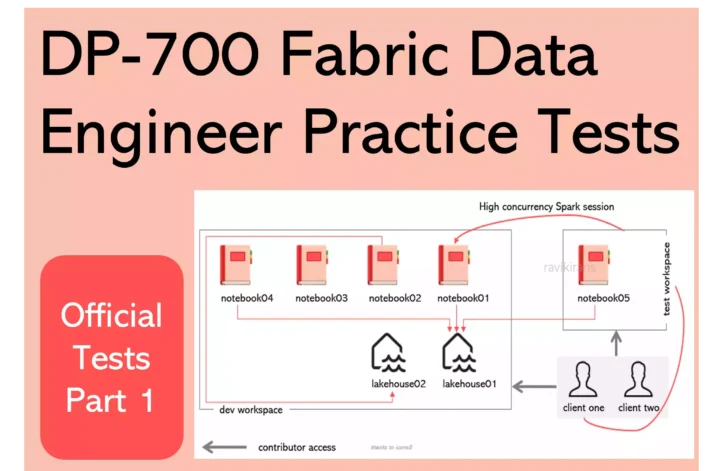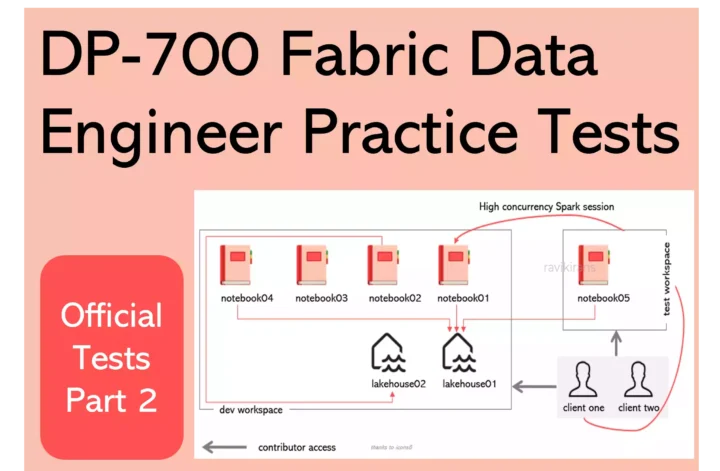DP-700 Preparation Details
Preparing for the DP-700 Implementing Data Engineering Solutions Using Microsoft Fabric exam? Don’t know where to start? This post is the DP-700 Certificate Study Guide (with links to each exam objective).
I have curated a list of articles from Microsoft documentation for each objective of the DP-700 exam. Please share the post within your circles so it helps them to prepare for the exam.
Check out the DP-700 sample practice tests.
Exam Voucher for DP-700 with 1 Retake
Get 40% OFF with the combo
DP-700 Azure Administrator Practice Test
| Udemy Practice Tests | Microsoft Fabric Data Engineer Associate tests |
| Amazon e-book (PDF) | Azure Administrator Practice Test |
| Whizlabs | Microsoft Certified Fabric Data Engineer Associate |
Implement and manage an analytics solution (30–35%)
Configure Microsoft Fabric workspace settings
Configure Spark workspace settings
Workspace administration settings in Microsoft Fabric
Workspace Settings in Microsoft Fabric
Configure domain workspace settings
Domains – Microsoft Fabric | Microsoft Learn
Domain management tenant settings
Configure OneLake workspace settings
OneLake tenant settings – Microsoft Fabric
Configure data workflow workspace settings
Create and use Dataflows (Gen2) in Microsoft Fabric
Implement lifecycle management in Fabric
Configure version control
Overview of Fabric Git integration
Implement version control and Git integration
Implement database projects
Database Projects for Data Warehouses
SQL database tutorial – Introduction
Create and configure deployment pipelines
Overview of Fabric deployment pipelines
Get started using deployment pipelines
Configure security and governance
Implement workspace-level access controls
Capacities, Workspaces, and Access Control in Microsoft Fabric
Give users access to workspaces – Microsoft Fabric
Roles in workspaces in Microsoft Fabric
Implement item-level access controls
Permission model – Microsoft Fabric
Item permissions for Security & Governance in Microsoft Fabric
Implement row-level, column-level, object-level, and file-level access controls
Row-level security in Fabric data warehousing
Implement row-level security in Microsoft Fabric data warehousing
Column-level security in Fabric data warehousing
Implement column-level security in Fabric data warehousing
Object Level Permissions for Security & Governance in Fabric
Implement dynamic data masking
Dynamic data masking in Fabric Data Warehouse
How to implement dynamic data masking in Fabric Data Warehouse
Apply sensitivity labels to items
Apply sensitivity labels to Fabric items
Enable sensitivity labels in Fabric and Power BI
Endorse items
Endorse Fabric and Power BI items
Orchestrate processes
Choose between a pipeline and a notebook
Data Pipeline vs Notebook in Microsoft Fabric
Performance issues running pipelines and notebooks
Design and implement schedules and event-based triggers
Scheduling & Monitoring Data Pipelines
Implement orchestration patterns with notebooks and pipelines, including parameters and dynamic expressions
Use parameters in Real-Time Dashboards
Microsoft Fabric Data Pipeline Expression
Ingest and transform data (30–35%)
Design and implement loading patterns
Design and implement full and incremental data loads
Incrementally load data from the Data Warehouse to Lakehouse
Prepare data for loading into a dimensional model
Dimensional modeling in Microsoft Fabric Warehouse
Load tables in a dimensional model
Design and implement a loading pattern for streaming data
Get and transform events from streaming sources
Ingest and transform batch data
Choose an appropriate data store
Ingesting data into the warehouse
Choose between dataflows, notebooks, and T-SQL for data transformation
Solved: When to use the T-SQL notebook
Transforming data | PySpark, T-SQL & Dataflows in Microsoft Fabric
Create and manage shortcuts to data
Unify data sources with OneLake shortcuts
Create a OneLake shortcut – Microsoft Fabric
Implement mirroring
Configure Microsoft Fabric Mirrored Databases From Azure SQL Database
Ingest data by using pipelines
Ingest data into your Warehouse using data pipelines
Transform data by using PySpark, SQL, and KQL
Transform data with Apache Spark and query with SQL
Using Fabric notebooks (pySpark) to clean and transform real-world JSON data
Mastering End-To-End KQL Transformations In Microsoft Fabric
Transform data in a KQL Database
Denormalize data
Denormalizing a Snowflake Schema into a Star Schema
Optimize Data Model by using Denormalization
Group and aggregate data
Create GroupBy Aggregation using Fabric Data Warehouse
Aggregate transformation in mapping data flow
Handle duplicate, missing, and late-arriving data
Latency and accuracy considerations in Activator rules
Ingest and transform streaming data
Choose an appropriate streaming engine
Processing stream data with Microsoft Fabric Event Streams
Process data by using eventstreams
Microsoft Fabric event streams overview
Create an eventstream in Microsoft Fabric
Process data by using Spark structured streaming
Get started with streaming data in the lakehouse
Process data by using KQL
Microsoft Fabric Real-Time Analytics with KQL
Create windowing functions
Window Functions in Fabric Eventstream
Monitor and optimize an analytics solution (30–35%)
Monitor Fabric items
Monitor data ingestion
Monitor activities in Microsoft Fabric
Monitor data transformation
Monitoring the status and performance of an Eventstream item
Monitor semantic model refresh
Semantic model refresh activity in Data Factory for Microsoft Fabric
Four ways to monitor a semantic model refresh in Fabric
Configure alerts
Set alerts based on Fabric events in Real-Time hub
Create Activator alerts from a Real-Time Dashboard
Identify and resolve errors
Identify and resolve pipeline errors
Pipeline failure and error message
Identify and resolve dataflow errors
Solved: Dataflow Gen 2 fail error message
Dataflow (gen2) error: Couldn’t refresh
Identify and resolve notebook errors
Monitoring Spark (errors and cost) in Microsoft Fabric
Identify and resolve eventhouse errors
Manage and monitor an Eventhouse
Identify and resolve eventstream errors
Monitoring the status and performance of an Eventstream item
Identify and resolve T-SQL errors
Fix SQL Analytics Endpoint Sync Issues in Microsoft Fabric
Optimize performance
Optimize a lakehouse table
Delta Lake table optimization and V-Order
Delta table maintenance in Microsoft Fabric
Optimize a pipeline
Designing and Implementing Dynamic Data Pipelines
Optimize a data warehouse
Warehouse performance guidelines
Optimize eventstreams and eventhouses
Eventhouse monitoring overview
Optimize Spark performance
10x Spark performance improvement in Microsoft Fabric
Optimize query performance
Query insights – Microsoft Fabric
This brings us to the end of the DP-700 Implementing Data Engineering Solutions Using Microsoft Fabric Study Guide.
What do you think? Let me know in the comments section if I have missed out on anything. Also, I love to hear from you about how your preparation is going on!
In case you are preparing for other Azure certification exams, check out the Azure study guide for those exams.
Follow Me to Receive Updates on the DP-700 Exam
Want to be notified as soon as I post? Subscribe to the RSS feed / leave your email address in the subscribe section. Share the article to your social networks with the links below so it can benefit others.




